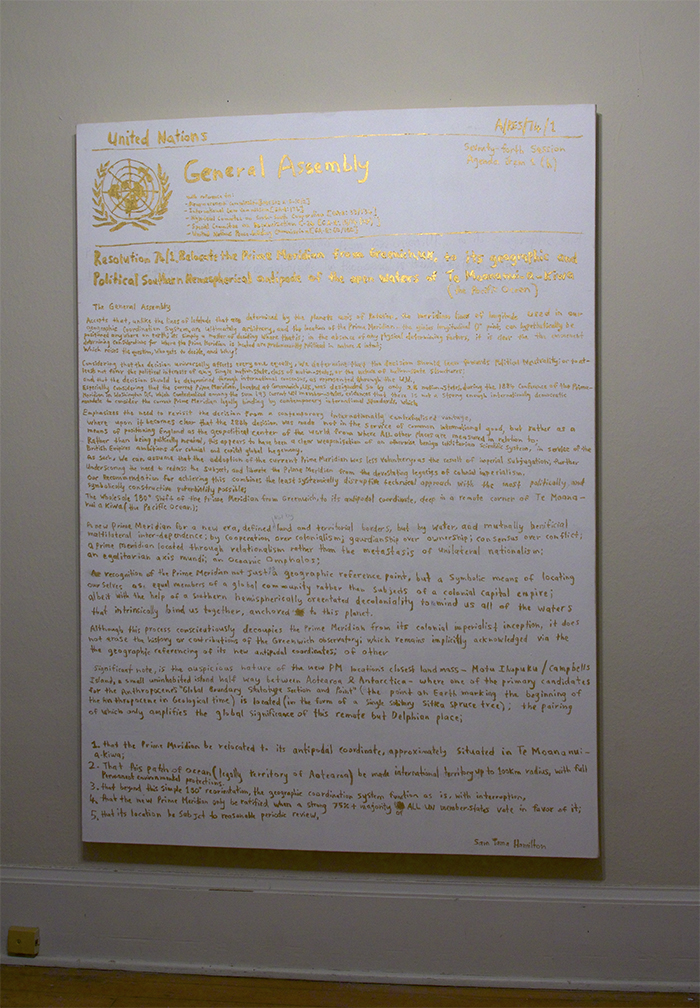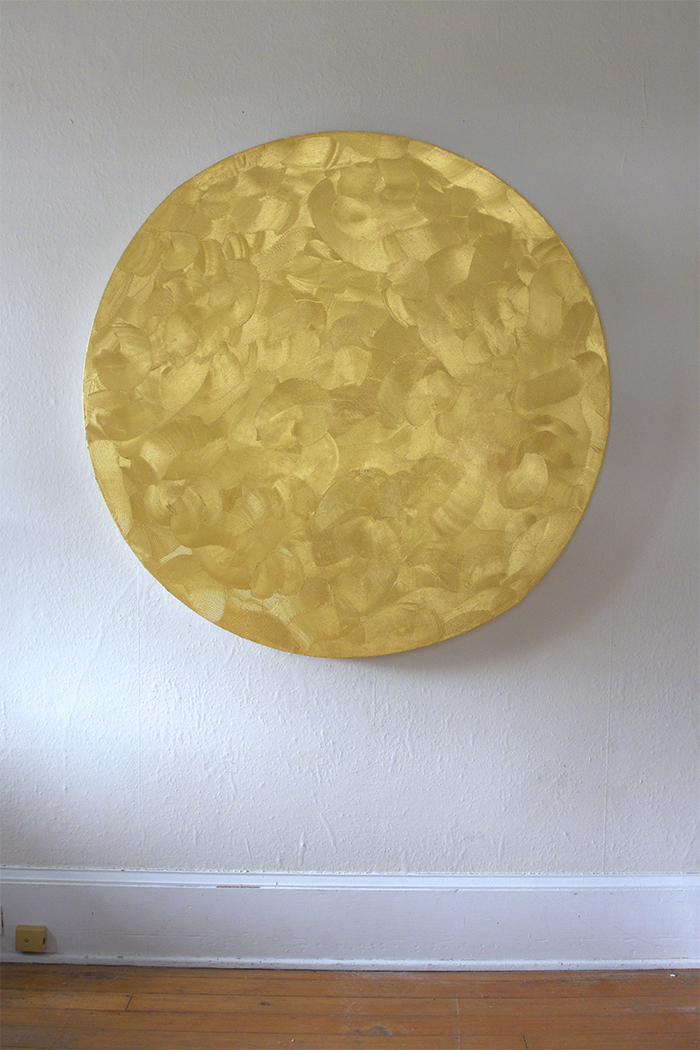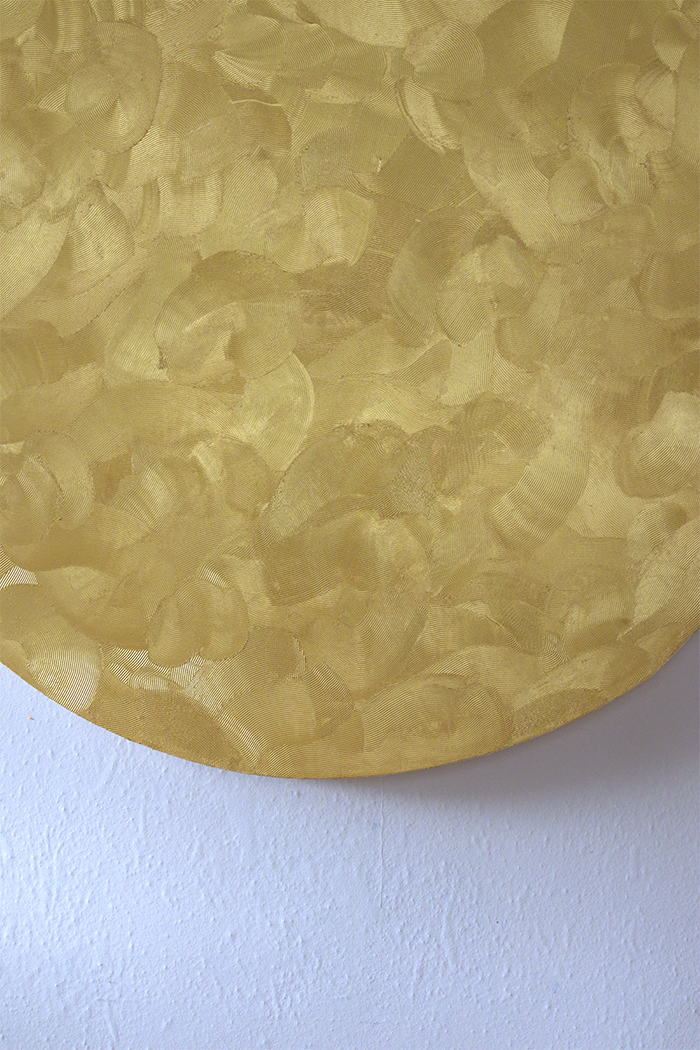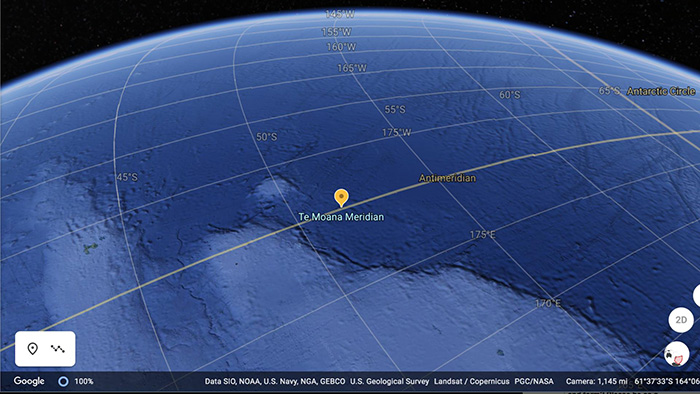Sam Hamilton
Te Moana Meridian is an interdisciplinary project directed by Aotearoa / US artist sam tam ham (Sam Hamilton) in collaboration with Dr. Tru Paraha, Holland Andrews, Mere Tokorahi Boynton, Vaimaila Urale, Clara Chon, a 40-piece youth choir, and others.
The project centers around the creation and delivery of a proposal to relocate the international Prime Meridian. The proposal is directed at the United Nations General Assembly, calling upon them to liberate this global infrastructural utility from 138 years of implicit servitude to western imperialism and metaphysical hegemony.
The project has been in development through 2020 with support from Creative New Zealand (the New Zealand Arts Council), with planned public presentations as an artist filmwork in 2021, and a live experimental opera performance work in 2022.

-S51.4779925, 180.00 (8.42mins, HD, video still)
Special thanks to DJ, Danial Gnu, Zoë Nicholson, Janet McAllister, Rhonda Tibbles, Melissa Laing, Leland Iron Works, Lauren Waudé, Avantika Bawa, Alexa Stark, and Creative New Zealand.
A new Prime Meridian for a new global era

Te Moana Meridian (English version of United Nations proposal), 44″ x 62″, acrylic on canvas, 2019.
The Geographic Coordinate System is an international system for defining, measuring, and communicating geographic coordinates based on latitude and longitude that respectively measure space north-south of the equator and east-west of the Prime Meridian.
Unlike latitude that uses the Earth’s rotational axis as a point of measurement, no such natural features exist to determine where to measure longitude from. The location of its Prime Meridian is technically arbitrary. It could be anywhere on Earth. The only thing that matters is that everyone agrees to use it. Indeed, before a single international Prime Meridian was determined, multiple regional prime meridians were in use around the world. The location of an international Prime Meridian is thus not a matter of nature, but of politics.
After decades of deliberation, a single international Prime Meridian was formally decided on in 1884 at the “International Conference of the Prime Meridian” held in Washington DC.
For the 26 nation-states that sponsored and participated in the conference, interests were inherently commercial, industrial, militaristic, and political in nature. But for many of the scholars that were present – who were largely responsible for advancing the premise of an international Prime Meridian to begin with – interests were often antithetical, if not positioned in explicit opposition to such nationalist interests. For many of them, the establishment of an international Prime Meridian was to be a harbinger that ushered in a new era of global modernity that they asserted should be defined by cosmopolitanism and humanitarian universalism. Central to this thesis was the clear idea that the location of the international Prime Meridian should be determined by the highest degree of political neutrality possible.
The Prime Meridian was to be an international utility in service of all humanity, and many locations were proposed including the Great Pyramids of Egypt, Jerusalem, the Canary Islands, and several major western astronomical observatories. One proposal that received wide and prolonged praise and consideration put forth by prominent scientist Sandford Flemming, was to locate the Prime Meridian in the Pacific Ocean / Te Moananui-ā-Kiwa, thus avoiding land and (Western) national interests entirely.
Despite the array of options and years of prior deliberation, all but three conference delegations voted to affix the new International Prime Meridian to the Greenwich Observatory in London, England, claiming it should be fixed to the scientific instrument with the greatest degree of accuracy in observing and measuring longitude.
Looking with a wider lens beyond this seemingly antithetical logic that if “X” observes “Y”, then “X” is “Y”, it becomes evident that other more implicit rationales were also at play, namely the distinctly colonialist and capitalist rationale that having the resources to claim and impose ownership over something begets a moral authority and obligation to do so.
Despite the claims of its impartiality, the “science” in this context not only fell prey to the manipulations of political interests but was covertly weaponised to serve it. For just as all roads led to Rome during the Roman imperial period, all GPS coordinates today point to London.
Rather than a Prime Meridian that serves all humanity, we have one that positions and privileges England as the center of the world from where all must measure their positions in relation to.
A situation that has functioned to implicitly legitimise and expand British imperial hegemony for 138 years, not only over much of the physical world but over our entire metaphysical notion of Universal Time and Space itself.
Rather than being the symbolic result of international consensus and diplomacy, the Prime Meridian became a defacto monument to Western imperialism’s conquest over global diplomacy, and the British Empires’ particularly coercive geopolitical dominance over international commerce.
Although the results of the conference impacted every nation on Earth, only 26 of the then 128 sovereign nations were represented, and of them, only 2 were not represented by white European men (Japan and Turkey, also imperialist nations of the day). This demographic stacking of the odds only functioned to subvert the conference proceedings towards an implicitly white imperialist/colonial outcome. But just as the Prime Meridian of 1884 ushered in an era of global modernity that violently burned its way through the centuries, it can again be used to usher in a new, difficult kind of era, shaped by the kind of just, restorative, and equitable world vision our future so critically needs.
So beyond promoting its long over-due critique, we suggest enough evidence exists now to justify relocating the Prime Meridian carte blanche – which sounds complicated but is in fact technically very simple. Indeed, the hardest part is making the choice to do so. A choice that, unlike in 1884, we now have the diplomatic apparatus needed to effectively achieve a renewed and more equitable international consensus with: the United Nations General Assembly, to whom we hereby propose draft and ratify the following resolution to:
1. Relocate the Prime Meridian,
2. as physically and metaphysically distant as possible from the spectres of predatory Western imperialism, colonisation, and capitalism,
3. and designate the territory an international sanctuary.
4. We thus propose relocating the Prime Meridian 180-degrees to its antipodean coordinates in Te Moananui-ā-Kiwa / the Pacific Ocean.
A Prime Meridian defined not by land, terrestrial ownership, and national self-interest, but water, environmental guardianship, and international solidarity. A Prime Meridian anchored in the ocean, in the Global South, connected to everything via the unbound and vital life-giving omnipresence of the planet’s hydrosphere.
A Prime Meridian capable of fulfilling its promised potential as the relational Axis Mundi of a new global commons.
He tono ki te Rūnanga Whakakotahi I ngā iwi o Te Ao hei whakataunga mō te Poutūmaro tuatahi.

Te Poutūmarotanga o Te Moana (Te reo Māori version of United Nations proposal), 44″ x 62″, acrylic on canvas, 2020.
Ko te pūnaha mātai matawhenua taunga ahuroa he pūnaha o te ao ka tautuhia, ka inea, ka whakaputatia I ngā matawhenua taunga ahuroa ki te whakaahua, ki te ine, ki te whakakōrero I ngā matawhenua taungaroa mā ngā ahopae, me ngā ahopou, hei ine I te ātea o te ahu whakateraki ki te tonga o te weheruatanga o te ao ahu whakaterāwhiti ki te uru o te Poutumaro tuatahi.
Tō te mea kāre kē he aroaro whenua hei whakakitekite i a ia, ko te taunga o te Poutūmaro Tuatahi o te ao he mea hanga noa, pēnei ana ko hea, ko hea I runga I te mata o Papatūānuku, ko te mea nui kia whakaaengia te katoa ki te whakamahia. Ko tana wāhi nohanga ehara I te mea I nō te ao tūroa, engari he mea tōrangapū.
Ko tana nohanga I tohetia, I whakakaupapatia I te “Whakahuihuinga o te Ao mō te Poutūmaro Tuatahi” I tū ki Washington DC I te tau 1884, I mua noa atu ka hia kē nei ngā tini maha o ngā poutūmaro a tēnā whenua, a tēnā whenua.
Mō ngā whenua tupu rua tekau mā ono I tautoko, I uru atu ki roto I te wānanga, ko ngā hiahia I aronui atu ki te arumoni, ki te ahumoni, ki te tungarahu, me te tōrangapū. Engari mō te tini o ngāi mātauranga nāna te wānanga I ārahi, ko ā rātou hiahia he āpiti atu, pēnei pea te mutunga mai o te tauaro ki ngā matea-a-whenua tupu I tohengia, hoki atu, hoki atu. Ko te Poutūmaro Matua me whakataunga mā te tiketike rawa o te noho kore here ki tētahi tōrangapū o te wā. Ki a rātou, ko te whakatūria I te Poutumaro-a-ao koia ko te kaikaranga I te oranga hou a te whakatipuranga hou huri noa te ao – ahakoa rā he kuare, he mariu rānei – ka takina tonuitia me te whakatauhia mā te iwi whakauruuru me te iratangatatanga mō te katoa.
Ko te Poutūmaro Tuatahi he taonga whakanui mā te ao katoa mo ngā tangata katoa , tini maha ngā nohanga I whakatauhia pēnei I ngā Koke Tapatoru o Ihipa, Hiruhārama, ngā Motu o Kānari. Me ētahi atu whare mātai kōkōrangi o te ao kiritea. Tērā tētahi tono I whakawhiwhia I te whānui me te whāroa o te whakaaro nui , me te whakatītina ko tērā I whakatakotoria e te Toihuarewa Pūtaiao a Sanford Flemming, hei tāna me tautohu atu te Poutūmaro Tuatahi ki Te-Moana- nui-a-Kiwa, nā reira i kauparetia atu I te noho whenua me ngā matea, o te ao kiritea pōtaea.
Ahakoa ngā whiringa take me ngā tau kōkirikiri, ka mahue ko ngā māngai e toru I pōtitia kia hono atu te Poutumaro Tuatahi o te Ao ki te whare mātai kōkōrangi o Greenwhich ki Rānana, Ingarangi, taunahatia atu me hono marotia ki te taputapu putaiaio mana te whakatautika o te titiro me te ine I te ahoroa.
Ki te titiro tua noa atu ki te takenga mai o te ariā mehemea ko “X” ka titiro atu ki a “Y”, kāti ko “X” koia a “Y”, marake ana te kite atu arā kē atu ngā kēhi e tākarohia ana I te wā, e whakahuatia ana ko te Koronitanga me ngā Iwi Hāunga Moni atu ki a rātou ngā rawa e āhei ai te kokoraho atu ki runga I tētahi mea ka matatikangia ōna mana, me ōna here kia pēnā.
Hāunga e tōkeke ana, ko te mātauranga “pūtaiao” I tēnei horopaki ka hinga I ngā rāwekeweke at ngāi tōrangapu heoi, huna mātārae atu, hei rākau nā Tūkaniwha. Meingia ana ko ngā rori katoa ka ahu atu ki Roma I te wā o ngā Romana, ko ngā matawhenua taunga ahuroa katoa ka ahu atu ki Rānana.
Hāunga te Poutūmaro Tuatahi ka noho mō ngā iratangata katoa, kei a tātou tētahi ka tūpou atu ko Ingarangi kei runga I te katoa, koia te mutunga mai o runga. Me ine te ao me ō rātou tūnga kia kite te whanaungatanga mauhere ki aia. E tūāhua kua whakaturengia te whakawhānui atu I te whakatuanui-a-mātauranga ki Piritania, me te whakatuanui-a-mātauranga a te Karauna o Ingarangi mo nga tau 138, kaua ki runga te tini o nga ao ahūpungao engari ki runga I te katoa o tēnei mea e mōhio nei ko te wā me te ātea.
Hei ahakoa rā kāre I noho hei tohu whakapūmau I ngā whakaaetanga o ngā māngai o te ao, ko te Poutūmaro Tuatahi I puta ake hei hāwini mā te whakatuanui-a-mātauranga o Piritania tērā rau o te patu ki runga I ngā māngai whakahangahanga o te Ao o tērā wā. He hua nā te kaikiri, nā te uruhi, nā te mūrere whakatuanui I te tōrangapū-a-matawhenua o te ao, I whakarahi ake mā te wānanga nei me ōna piriraho hei whakamakau atu I te taioreore o te Kiritea, e pūtohe ana mā ngā tane kiritea hāunga ētahi atu tāngata nā te 26 noa iho o aua whenua mana motuhake o te 128 whenua motuhake katoa , he Kiritea te katoa apiti atu ko ērā tāngata nō Hāpani me Tākei. (Ēnei whenua anō hoki he whakatuanui a te karauna).
Engari I a te Poutūmaro Tuatahi e mahuta ake I te pae o 1884 I hou mai te ao hou nānā I whakarekereke te tahu whenua I roto I ngā rau tau, e tarea ana te pēnei anō, he pae hou, he pae tata, he pae mōniania, mana e whaowhia I te manatika, I te mana whakahouhia, I te mana tōkeke hei aronganui mō te ao e kaha pīrangitia ana hei ngā pae tawhiti e heke tonu nei.
A tēnā, ki tua noa atu I te whakatenatena I te roa o te waru kia tātaringia tēnei kaupapa, meingia ana he nui rawa ngā taunaki e noho ana I te wā mana e parahau te take me nuku te tautohu o te Poutūmaro Tuatahi, hikina katoatia hāunga ki te taringa he uaua kia whakatutukihia. Hei tāna kē he māma noa iho – he whiringa whakairo noa iho. He whiringa whakairo, kaua hei tā 1884, ināianei tonu kei konei te tumatawhānui-a-ao, māna tēnei kaupapa e whakawhiwhia – mā te pono me te tika o te whakatau
waenga ngā mangai katoa o te ao I roto I te Rūnanga Whakakotahi I ngā iwi o Te Ao. Ki a koutou e whakatakotoria e mātou tēnei tono tauākī me whakapūmautia tēnei mōtini:
- Me nuku te tautohu o te Poutūmaro Tuatahi,
- Kia mamao, kia tawhiti rawa I ngā paetara o te ngau kino o te kaikiri, o te whakatuanui a te karauna I mahuta ake I te iwi Kiritea, nānā anō te horo whenua, horo tangata, horo tikanga, horo rawa.
- Me whakatauhia te wāhi nei hei Taiāpure a Ao.
Nā reira e whakataungia e mātou me nuku te Poutūmaro Tuatahi ki te 180 Pā mahana ki ana tautohu ahopae , ahoroa ki te Moana nui a Kiwa.
He Poutūmaro Tuatahi kāore I whakaahuangia mā te whenua, mā te hoko whenua, mā te apo a tētahi, engari mā te wai, mā te kaitiakitanga o te Taiao, mā te mana motuhake a te whaiao ka whakaaetia e ngā Rangatira o te ao o tēnei wā. He Poutūmaro Tuatahi ka toka tūmoana, ki te whakatetonga o Te Ao, e honongia ana ki ngā mea katoa mā te mana ora ongā wai tukuora o Papatūānuku, o Ranginui, o Tangaroa.
He Poutūmaro Tuatahi e tareka te whakatūtuki I ngā ōhākī I wawatatia ai hei pito o te ao, nō roto mai I ngā rawa taiao o Papatūānuku.
Author: Sam Hamilton
Editor: Janet McAllister
Te reo Māori translation: Rhonda Tibble


-S51.4779925, 180.00, 45″ x 45″, acrylic on canvas, 2020. Detail right.

Te Moana Meridian Google Earth coordinates

Te Moana-nui-ā-Kiwa, 4×5 film, 2020.

Vaimaila Urale, Untitled, 2021, artwork for Te Moana Meridian poster.
Sam Hamilton (Sam Tam Ham) is a working-class interdisciplinary artist and creative researcher from Tāmaki Makaurau, Aotearoa New Zealand, currently based in Portland, OR, USA. They are a 3rd generation Pākehā (white New Zealander). Their practice functions more like an ecology than a discipline. It has been a vessel for researching the relationality between environmental sound and artistic research in the Amazon rainforest; working inside an active volcano crater; filming at remote mountaintop astrophysics observatories (not Mauna Kea), touring internationally for a decade with the Lemi Ponifasio/MAU Dance Company; directing experimental film/live performance programs for the NZ International Film Festival; filming in Sāmoa with Ioane Papali’i; collaborating with youth choirs on deep listening choral projects; performing at ISSUE Project Room (NYC), a Shinto Shrine (Nagoya, Japan), Dockfest (Germany), Extrapool (Netherlands), an anarchist squat in downtown Athens, (Greece), a queer-goth bicycle co-op in Tempe (Arizona); and presenting work at Whitechapel Gallery (London), Portland Art Museum (Oregon), Transmediale (Berlin), Locust Projects (Miami), ARTSPACE (Aotearoa), Center for Contemporary Art & Culture (PDX), St Paul St Gallery (Aotearoa). Samhamilton.org